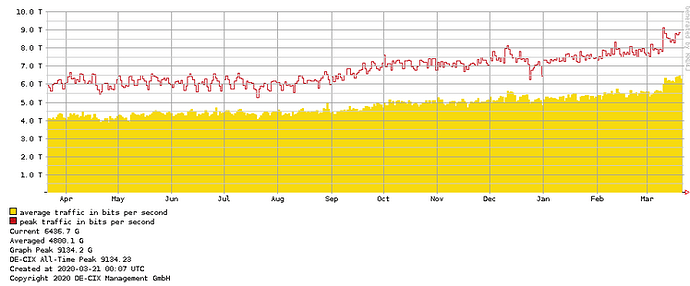They’re upset about being limited to gatherings under 50 people.
Maybe he can go meet in some state pastureland with the Bundy family and get back to fighting for his right to steal from his neighbors.
Welp, looks like they’ll do their part to help pad things while capacity ramps up.
Saw this the other day, but didn’t get around to saying something about it:
The problem is that it is… but availability of that bandwidth to customers is different from availability between providers. A sudden large shift in where bandwidth is being used, as well as what times it’s being used, can cause backbone and provider interconnects to get saturated, causing latency and loss for everyone with traffic trying to pass through those points, and increasing bandwidth at those points is often difficult to push through on short notice even if it doesn’t get caught up in negotiations. Plus, it’s anyone’s guess whether some of that will be relatively temporary or if permanent capacity changes need to be put in place.
In the little portion of the internet where I work there has been a definite and sudden shift in the last week or two in what kinds of traffic there is, and when, since everyone who is suddenly working from home is accessing their work’s networks remotely, or streaming videos, or whatever else. Due to the way this has spread, Europe in general is probably a bit ahead of the curve on the stress that can put on the networks.
Yeah, here in .be, our ISP (Proximus) is doing fine. We have gigabit fiber to the premises. My home network is maxed out, though. 10 people here and we’re all online. Citrix, which I’m using for WFH, is a hog. Ditto the kids’ school apps.
My wife tele-attended a “town hall” meeting at NIH with Director Francis Collins. Apparently in the NIH labs they have developed a vaccine in two months, the fastest ever. It will still take a long time to get into the hands (poked into the arms?) of people, but they are going to soon test it on volunteers, for safety.
Apparently there was a case of someone in China supposedly recovered from COVID 19 who relapsed. I hope this isn’t a thing.
Meanwhile at the White House, Dr. Anthony Fauci of NIH doing a facepalm:
I’m drunk at 2 pm from a Zoom happy hour with a collleague. We resubmitted a paper and it was 7 pm there.
Edit: If anyone wants to chill for a bit later, I can put the zoom room back up.
live free AND die!
I think netflix is being blamed, and there are other stressors on the network that haven’t been optimized for. Reducing streams to 480p sounds like an easy fix, but home network delivery has long been designed around video streaming. It hasn’t been designed around zoom, or TeamViewer or corporate paranoia.
It keeps people in their homes, away from crowds, away form theatres, way from bars or restaurants.
There is value in it. Don’t discount it and blame it for all your problems.
Argh! Thanks for the earworm! 
Home network delivery just shifts bits. It doesn’t need to be designed around those things. It’s a capacity and interconnect thing. And a supply chain thing. Home network delivery is only the last mile.
It’s not that it’s to blame for all the internet’s problems - it’s that it over 60% of internet traffic and could contribute to even larger problems, and asking users to go with a slightly lower resolution for a short while in the middle of a crisis is not that big a price to pay. No one’s going to die due to not seeing a show in its full 4k glory.
It just hit me, he’s quarantined himself in the Red Room.
I must confess I was significantly underestimating the share of bits devoted to streaming.
However, consider
EMEA download traffic:
HTTP MEDIA STREAM 16.4%
NETFLIX 13.8%
YOUTUBE 11.8%
BITTORRENT 5.3%
AMAZON PRIME 4.2%
and constrast it with the uploads
BITTORRENT TRANSFER 44.2%
HTTP MEDIA STREAM 10.6%
WEB RTC 3.8%
GOOGLE 3.8%
YOUTUBE 2.1%
Suddenly, a whole new client base is interested in telephony-- people forced to work from home, and people forced to learn from home. And upload traffic is forced into a tiny pipe.
(If bits are bits, and networks are by their very nature bidirectional, why does every cable internet offer packages like this?
" Xfinity from Comcast Internet Pricing
| Internet Package | Download Speeds Up to | Upload Speeds Up to |
|---|---|---|
| Performance Starter | 25 Mbps | 2 Mbps |
| Performance | 100 Mbps | 2 Mbps |
| Blast! | 200 Mbps | 5 Mbps |
| Extreme | 300 Mbps | 5 Mbps |
Easier-to-follow data:
https://www.worldometers.info/coronavirus/
Using the log scale, things seem to be worsening all month.
Alive, healthy and working from home over here.
I do not work for the cable/dsl/etc home provider industry (my wheelhouse is the opposite end, and a portion of the path inbetween), but this gets into some of the annoying parts of my job, so I can talk about a few points here. I apologize if I re-tread anything you already know.
Got a little long, so I'm collapsing it to avoid a wall of text that's a bit offtopic...
Plans are like this, as far as I know, due to a combination of technology and business reasons.
On the business side, it’s good for the provider to have more traffic going to their customers than in the other direction - that lets them take a negotiating position of (if I simplify it a lot) “you want to send traffic to us, so we should pay less (or nothing) for the hardware/bandwidth involved”.
On the technology side, first, due to distance/the media in use/upkeep, it’s usually easier to send data to the home from a central location than in the other direction.
Second, networks are bidirectional, but the directions don’t balance. If you fetch a website, you’re sending packets to the other side of them too, but there’s a lot less of them and they’re a lot smaller (since they’re the computer version of listening to someone and occasionally saying “yeah. uh huh…”). Most home users still use more in the incoming direction than outgoing, so home connections prioritize that. The bad side is that it ends up being a bit of a self-reinforcing thing, but that’s a whole other argument.
That last one is also why the proportions of home user upload traffic are less important (in the U.S., at least) than download. If a home user swamps the upload speed of their own connection, they’re unlikely to cause problems for anyone but themselves. But, a large number of home users pulling large amounts of download at the same time, and particularly at a time they’re not expected to, could swamp the connection from their provider to another provider… or that provider to another one… and so on. Depending on where and when it moves around, it can pile together with normal traffic that hasn’t moved, and drive a new peak that wasn’t planned for.
There’s also the always-present chance that a provider could have a sudden hardware failure on a large link, which could drive some or all of the traffic on that path to go through other links or other providers. That can have cascading consequences, and the risk is higher if traffic is abnormally high at unusual times of the day.
I’ve been compulsively checking that website every day.
I’ve been hitting my head with a hammer too.
Good.
Journal of the Corona Year
3/20
I now have an internet connection that will allow me to work remotely. And just in time, too.
The Spectrum store didn’t open until 10:00 AM. I could wait, but there was no guarantee anything good would come of it. So I went into work, hopefully for the last time. In two hours I rushed through everything that was possible for me to do. Then I headed back to Brooklyn.
I went to their 86th Street store. I wondered if they were even going to be open. I’d have to have to have the modem and router shipped to me if they weren’t. I supposed that would still be possible.
There were a couple of notices on the door regarding store hours changing for easter, but they were open.
Inside, the store was very clean and everyone was very friendly. It was nice. The manager said they were open because in the current situation they were considered an essential business. I wondered how long that would last.
The manager also said he was continuously keeping all the touch-screen devices disinfected. But I still had to sign a receipt with a pen sitting in the counter.
I got the boxes and the cables, and walked the ten blocks to my building. It would be my only exercise and fresh air for the day.
I got home, set everything up, and to my relief the modem actually connected to the internet. God bless you, Spectrum. I sent out an email to all concerned parties — I was now ready to work, in lonely isolation.
So now I have two black plastic box filled mostly with air, two DC power supplies, a coaxial cable connected to the outside world, and an ethernet cable connecting the two boxes. They are covered in lights, on the front and on the back. It’s a mess sitting on the floor prepared to collect dust.
On Instagram tonight I saw a post from Brooklyn Film Camera. The governor had ordered all non-essential business to close. They were lamenting that after four-and-a-half years they were now facing an uncertain future. They had even set-up a GoFundMe page to try and keep their staff paid.
So I suppose it’s a good thing I got my dry cleaning yesterday. But I guess I won’t get my new glasses next week. I have a bad feeling about all this.
Pulling my rambling back to Covid-19’s effects… the DE-CIX peering exchange (basically a network that helps other networks connect (almost) directly to each other rather than routing through other internet providers, based in Germany) released some interesting statistics:
Internet usage increase observed at DE-CIX Frankfurt
In Frankfurt we have seen:
+10 % increase in average data traffic
Over 9.1 Terabits per second data throughput – a new world record
50% increase in video-conferencing traffic (Skype, WebEx, Teams)
25% increase in online and cloud gaming and in traffic from the use of social media platformsWe will continue to monitor the traffic and share more insights in due course.
And their 1-year graph:
That’s roughly a 1 Terabit per second jump in their peak over the last week there at the end. Also shows the stark difference between average and peak. And they aren’t even a general internet provider…

